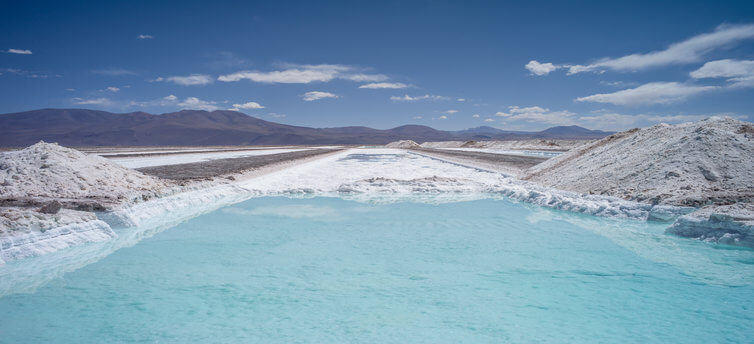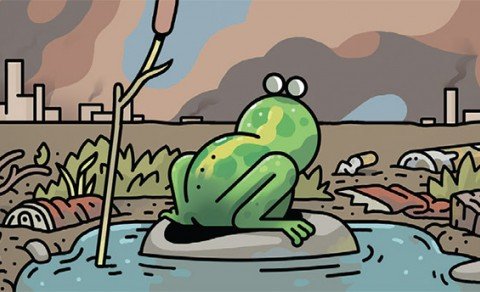Purmamarca, ARGENTINA – When Tesla Motors revealed in February it would build the world’s largest lithium-ion battery plant, shares in major lithium producers such as SQM, FMC and Rockwood – all active in South America’s so-called lithium triangle – got a noticeable boost.
Tesla pledged to invest more than $5 billion in its factory, construction of which would begin in 2017 with an eye to producing 500,000 batteries a year. Analysts now expect the Palo Alto, California-based electric carmaker to strike a strategic lithium supply agreement in the near future.
When that deal comes through, it could be huge. Tesla alone might represent an 8 per cent increase in global demand for lithium, and that’s good news for countries in the lithium mining game. Yet it’s unclear to what extent South America’s resource-rich nations will truly benefit from it, and whether the foreseen “white gold rush” will be a sustainable one.
Just a few days before Tesla’s announcement, Bolivian President Evo Morales was dressed in white overalls, carefully examining a battery cell during the inauguration of a pilot manufacturing plant, located within the 10,000 square kilometre salt flats of Uyuni. “If we have the greatest reserves worldwide, why not have the greatest lithium industry here in Bolivia?” he asked.
Unlike its neighbours, Bolivia still lacks its own lithium production infrastructure, and there remains some confusion over the exact size of its lithium reserves. But that wasn’t Morales’ concern. He was there to promote a vision: that lithium could be Bolivia’s ticket to being an industrialized nation.
For years, governments in the lithium triangle – which includes Chile, Bolivia and Argentina – have pledged to take advantage of their respective lithium deposits. In 2011, Argentina suggested that the countries create an “OPEC-like” arrangement on lithium outputs. Newly elected Chilean President Michelle Bachelet said during her campaign that she would put together a special commission charged with determining how the country, which holds more than 25 per cent of global reserves, could draw the most from its resource.
But how large is the opportunity? Chile, which Forbes magazine has called the “Saudi Arabia of lithium,” currently produces up to 60,000 tonnes per year of lithium carbonate, making it the largest producer globally. Production in Chile has more than tripled since the beginning of 2000.
Sounds impressive, but the big picture tells a different story. Lithium is still a third-class commodity market, roughly $1 billion in size globally. On its own, Chile exports a little more than $200 million annually. That’s less than 0.5 per cent of the value of its copper exports. In other words, even in the world’s largest producing country, lithium exports make up less than 0.1 per cent of its GDP.
“There is an illusion around lithium,” says Jaime Alée, director of the Lithium Innovation Center in Santiago. “We can’t talk of a rush for something that has such little economic value for the country. Global lithium production works out to less than a month of copper production in Chile.” Alée doesn’t think that the expected increase in global demand will change the situation.
“We see that the global commodity market will increase to $2 billion in 2020. This is still a negligible amount compared to other mineral commodities.”
The substance being exported is called lithium carbonate, a commodity through which lithium – originally found in its soluble state in nature – can be transported. This white, salt-like powder contains about 18 per cent of metallic lithium. Its current price on the market has grown from less than $2,000 per tonne before 2000 to up to $7,500 in 2007. The price has since stabilized between $5,000 and $6,000 with global production around 150,000 tonnes annually.
“What our clients do is buy our lithium carbonate to produce the chemical product used in cathodes, thus multiplying its value 20-fold,” says Alée. “These cathodes are then sold to battery producers, and so on. In the end, our lithium makes up less than 0.5 per cent of the value of the battery in the car. It’s exactly like quartz and quartz watches: The value of the mineral itself is small in comparison to that of the watch.”
According to a Seeking Alpha report, esla’s current Model S uses no more than 100 pounds of lithium carbonate, putting its value at about $135 in a vehicle that sells for $70,000.
Alée says Chile, Argentina and Bolivia must do more than simply export the base mineral if they are to make the most of the lithium rush. To break free from their historical status as just natural resource providers, the countries need to climb the value chain by themselves becoming the manufacturers of batteries and their components.
Nature’s gift
Unlike other minerals in the region, such as gold or copper, lithium extraction does not come with major environmental risks. It is naturally found in its soluble state in the brines below the salt flats. For two million years, it has been carried away from the surrounding volcanic rocks through the waterways, and thrown into these vast pockets of salt, along with other minerals. In Salar del Rincon, where ADY Resources – a subsidiary of the Canadian-based Enirgi Group – launched a 500-tonne pilot plant in 2012, natural concentration of lithium in the brine is roughly 0.035 per cent. ADY plans to build a production plant in 2018 that would process about 25,000 tonnes a year.
Lithium producers use natural evaporation, rather than heat, to increase lithium concentration in the brine. In other words, being sustainable is what makes these projects more profitable. By simply pumping the brine into shallow pools, the exceptionally sunny conditions of the desert evaporate most of the water, forcing undesirable minerals to eventually settle to the bottom – like a glass of water oversaturated with salt and left to sit on the counter. “The only impact that I see we will have here is that the concentration of lithium in the brine will decrease over the years,” says Carlos Galli, operations manager at ADY.
None of the products used in the process, including lime, sodium carbonate and sodium sulphate, are toxic. The main waste that’s generated is a greyish, crumbly material called gypsum (used in drywall and toothpaste), mixed with magnesium hydroxide. “This is the most dangerous waste we have,” says Galli. “And it’s not dangerous.” ADY, in fact, is exploring ways of separating the magnesium so it can be sold as a by-product.
In fact, most of the waste resulting from lithium extraction could become commercial by-products. Among the minerals deposited at the bottom of the pools is potassium chloride, which is in demand in neighbouring Brazil for use in fertilizers. Salt chloride – or common salt – also has value, but ADY has refrained from selling it because it would damage local artisanal production. “We can’t just let our big project break the local market,” says Galli. “So we decided to put our salt at the disposal of local communities.”
Many lithium producers in the region have been careful to hire as much of their staff as possible from the surrounding, poor Colla communities. Of the 168 employees of ADY, about 110 are Collas. Gaining social licence to operate is particularly challenging for companies such as ADY. Lithium producers generally have smaller financial resources than the gold, copper or silver producers in the area, so funding for corporate social responsibility programs is limited. “We need to be creative,” says Galli.
Great expectations
Paradoxically, the greatest challenge that lithium producers face comes from the high expectations politicians and the media have created for the industry. By exaggerating the importance of the lithium market and its potential benefits, there is pressure to deliver.
The truth is that countries like Chile and Argentina are still struggling to develop basic national energy plans, let alone clear strategies for the future of a single commodity like lithium. This has led to growing frustration and sometimes cynicism among the population, which sees the technological race to batteries being dominated by other countries.
According to Navigant Research, electric vehicles will drive so much demand for lithium-ion batteries that the market is expected to grow from $6 billion today to $26 billion by 2023. Compared to the $2 billion market that the commodity itself could reach in 2020, it is obvious that only a negligible share of this boom will remain in lithium-producing countries.
“I think Chile could increase how it adds value, but there is a lack of scientific and technological policies to do so,” says Guillermo Gonzalez, professor at the department of chemistry at the University of Chile and an expert on lithium batteries. “We don’t create new things here. We don’t generate wealth from knowledge, as is the case in more developed countries.”
Many have been critical of major players such as SQM – Chile’s top producer with a production capacity of more than 40,000 tonnes of lithium carbonate – because they do not process their product to its full potential. They prefer instead to export the raw material, thus contributing to the widespread feeling that Chile “is missing the train.” It’s the same kind of criticism launched against oil developers in Canada, which exports raw bitumen to the United States where it is refined into a higher value product.
“These companies have no interest whatsoever in processing their products,” says Gonzalo Gutierrez, an expert on lithium applications in the physics department of the University of Chile. “Lithium extraction is extremely simple; it could have been carried out in the year 1000. So when you hear SQM saying that it is innovating new technologies, it’s simply not true.”
It’s why observers such as ADY’s Galli see a need for a reality check. There’s a mismatch, he says, between the vision for lithium – as a key material in electric vehicles and batteries – and the facts on the ground. Regions that boast the greatest reserves of lithium may be setting themselves up for disappointment.
“These grandiose speeches on lithium are generating expectations that we simply will not be able to meet, and that will ultimately prove to be a disservice to our industry,” says Galli. “Lithium will not save the economies of Salta, of Jujuy, or of Argentina as a whole, and I don’t think that it will save Chile’s either.







